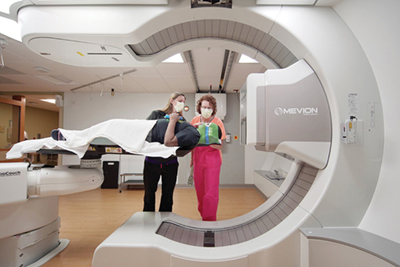BY JEN MILLER While radiation is a key part of therapy for 70% of people treated for cancer, its side effects can be significant. That doesn’t mean radiation shouldn’t be used; it is an effective treatment. But making radiation more targeted can mitigate side effects. That’s where pencil beam proton therapy comes in.
https://www.barnesjewish.org/Portals/0/Images/curiosus/web_bedaide_pencilbeamVI.jpg?ver=2021-02-18-125727-533
“This precise way of delivering radiation gives us an even greater ability to intricately shape the dose, especially around the body’s critical structures,” says radiation oncologist Stephanie Mabry Perkins, MD, director of the S. Lee Kling Proton Therapy Center at Siteman Cancer Center at Barnes-Jewish Hospital and Washington University School of Medicine. The Proton Therapy Center started using the treatment in 2020 and is the only cancer center in the St. Louis region to offer it.
In standard radiation therapy, X-rays deliver energized photons that destroy cancer cells in the body. However, those same cancer-killing particles can harm surrounding healthy tissue. Protons are also energized particles but, unlike photons, they can be more precisely directed. While proton therapy itself isn’t new—it was first proposed as a treatment in 1946— pencil beam proton therapy is the latest development of the technology. In this newest iteration, protons are delivered with a beam that “paints” the radiation dose onto the tumor.
 A PENCIL BEAM SYSTEM CAN DELIVER PHOTONS TO A CANCER TUMOR MORE PRECISELY THAN AN X-RAY MACHINE.
A PENCIL BEAM SYSTEM CAN DELIVER PHOTONS TO A CANCER TUMOR MORE PRECISELY THAN AN X-RAY MACHINE. Not only does this limit damage to other parts of the body, it also can be tailored to a person’s specific tumors and surrounding anatomy. “With this new machine, we’re able to take a CT scan of the patient while they’re in the treatment position and can evaluate any changes to their anatomy and tumor size,” Perkins says.
About 20% of people treated at the Proton Therapy Center are children. “Given what we know about radiation and its effects on memory and cognition, we want to make sure that we’re treating children for their cancers now while decreasing their risk of future health problems,” Perkins says. Currently, the center uses its pencil beam delivery system to treat tumors in the brain, thorax, prostate, breast and extremities. The increased precision of pencil beam scanning means there is now the potential to treat additional tumors, including head, neck, gynecological and liver cancers, among others.
Perkins notes that scientists at Washington University School of Medicine are participating in research focused on pencil beam proton therapy. “There are some unique biological effects of proton therapy that we’re working to understand more fully.” For instance, she says, “we’re interested in further examining the ways proton therapy deposits its dose in tissue.”